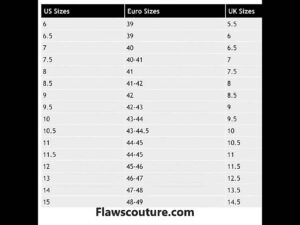Shoe sizes can often be a source of confusion, especially when traveling or shopping from international brands.
One common point of puzzlement is the conversion between European and UK sizes.
Let’s demystify European size 43 in terms of UK shoe sizing.
European Size 43 in the UK
- Men’s Sizing: In men’s shoes, European size 43 typically translates to a UK size 9.
- Women’s Sizing: For women, a European size 43 often corresponds to a UK size 8.5 to 9.
Factors Influencing Shoe Sizing and Fit:
- Brand Variations: Even if the conversion charts say one thing, individual brands may have slight variations in sizing. Always refer to a specific brand’s size chart when available.
- Style of Shoe: The same size can feel different depending on the shoe’s style. For instance, high heels might fit differently compared to flats, even if they’re both labeled as size 43.
- Material: Some materials, like leather, can stretch over time, affecting the fit of the shoe. On the other hand, synthetic materials might not offer the same flexibility.
- Width: Shoe size isn’t just about length. The width of your foot plays a significant role in determining the right shoe size. Some brands offer shoes in varying widths, from narrow to extra-wide.
Tips for Finding the Perfect Fit:
- Measure Later in the Day: Our feet tend to swell slightly throughout the day, so it’s advisable to measure them in the evening for a more accurate size.
- Consider Both Feet: It’s common for one foot to be slightly larger than the other. Always size shoes based on your larger foot.
- Think About Socks: The thickness of the socks you plan to wear can influence shoe fit. Try shoes on with the type of socks you intend to wear them with.
- Check Return Policies: When shopping online, especially from international brands, ensure the store has a reasonable return or exchange policy.
- Trust Your Comfort: Numbers are just guidelines. The most important thing is how the shoe feels on your foot.
In summary, European size 43 typically corresponds to a UK 9 for men and around UK 8.5 to 9 for women. However, various factors can influence shoe fit.
Always prioritize comfort and refer to specific brand size charts when making a purchase.
ALSO SEE: Shoe Size 40 in UK Sizing

FAQs: European Shoe Size 43 in UK Sizing
- Q: What is European size 43 in men’s UK size?
A: European size 43 for men typically translates to UK size 9. - Q: How does European size 43 convert for women in the UK?
A: For women, European size 43 is usually a UK size 8.5 to 9. - Q: Are shoe sizes consistent across all brands?
A: No, individual brands may have slight variations in sizing. - Q: Is there a difference in fit between styles of shoes with the same size?
A: Yes, for instance, high heels might fit differently than flats, even if both are labeled size 43. - Q: Can the material of the shoe affect its fit?
A: Yes, some materials like leather can stretch over time, while synthetic materials might not offer the same flexibility. - Q: Does width play a role in shoe sizing?
A: Absolutely. Shoe size isn’t just about length; the width of your foot can significantly influence the fit. - Q: What time of day is best for measuring feet for shoe sizes?
A: It’s advisable to measure feet in the evening as they tend to swell slightly throughout the day. - Q: Is it normal for one foot to be larger than the other?
A: Yes, it’s common. Always size shoes based on the larger foot. - Q: Should I consider sock thickness when choosing shoe size?
A: Yes, the thickness of socks can affect the fit, so always try shoes with the socks you plan to wear. - Q: Are online shoe size charts accurate?
A: While many are, it’s best to refer to a specific brand’s size chart when shopping online. - Q: If I wear a UK size 9 in one brand, will it be the same in another?
A: Not always. Sizing can vary among brands, so it’s essential to try shoes on or check a brand-specific size chart. - Q: How do half sizes factor into European to UK conversions?
A: Half sizes provide a more precise fit, but not all brands offer them. When converting, it’s best to round to the closest whole size. - Q: Are there any tools to help with shoe size conversions?
A: Yes, many online retailers offer conversion charts, and there are also mobile apps dedicated to helping with shoe size conversions. - Q: Is there a difference between adult and children’s shoe size conversions?
A: Yes, children’s shoe sizes follow different conversion scales, so it’s crucial to refer to the appropriate chart. - Q: Can I return shoes if they don’t fit correctly?
A: It depends on the retailer’s return policy. Always check the policy before making a purchase, especially online. - Q: Do shoe inserts or orthotics affect size choice?
A: They might. If you use inserts or orthotics, it’s a good idea to bring them when trying on new shoes. - Q: Are there any European brands known for fitting true to size?
A: Fit can vary even among European brands, so always check reviews or the specific brand’s sizing chart. - Q: Why might a shoe labeled both 43 EU and UK 9 not fit as expected?
A: Variations in manufacturing, design, and materials can all influence fit, even if the size label matches your usual size. - Q: Can I use US shoe sizes to convert to UK sizes?
A: It’s best to convert directly from European to UK sizes for accuracy, as adding another conversion can introduce errors. - Q: Why is there a difference between men’s and women’s shoe sizing?
A: Men’s and women’s feet often have different shapes and proportions, leading to separate sizing systems. - Q: How often should I measure my shoe size?
A: Foot size can change over time due to factors like age, weight changes, and pregnancy. It’s a good idea to measure every couple of years or if you notice changes in fit. - Q: Does European size 43 equate to UK 9 for sports shoes too?
A: Generally, yes, but sports shoes may have a different fit due to their design, so always try them on. - Q: Can weather conditions affect shoe fit?
A: Yes, heat can cause feet to swell, and cold can cause them to contract, so consider the climate when choosing a size. - Q: Do leather shoes in size 43 stretch more than synthetic ones?
A: Typically, yes. Leather is a natural material and tends to adapt to the foot’s shape over time. - Q: Should I buy a size up if a shoe is too narrow but the length is correct?
A: It might help, but it’s essential to ensure the shoe isn’t too long, which can cause other fit problems. - Q: Are there specific brands known to run larger or smaller in European size 43?
A: Yes, fit can vary among brands. Always consult brand-specific reviews or size charts. - Q: Do high heels in size 43 fit the same as flat shoes in size 43?
A: Not always, as the foot position in heels can change the fit. Always try on heels to ensure comfort. - Q: Are there any European countries where size 43 might fit differently?
A: While 43 is a standard European size, manufacturing variations can occur, so always try on shoes when possible. - Q: Can the shoe’s purpose, like formal versus casual, affect fit in size 43?
A: Yes, formal shoes might have a snugger fit compared to casual ones, even in the same size. - Q: How do I care for shoes to maintain their size and shape?
A: Use shoe trees or stuffing, avoid excessive moisture, and rotate wear to help shoes maintain their shape. - Q: Why do some shoes in size 43 have wider toe boxes?
A: Design and brand philosophy can influence shoe shape. Some brands prioritize toe comfort and movement. - Q: Are there any specialty stores for people who wear size 43 in the UK?
A: Most shoe retailers will carry size 43, but some specialty stores cater to specific size ranges. - Q: Can I customize a shoe if size 43 isn’t a perfect fit?
A: Yes, cobblers or shoe repair shops can sometimes make adjustments to improve fit. - Q: Why are there variations in width for the same shoe size?
A: People’s feet vary not just in length but also in width, so brands offer different widths for optimal fit. - Q: Are shoe sizes standardized globally?
A: No, there are different shoe sizing systems worldwide, like US, UK, European, and others. - Q: How does European size 43 compare to US sizes?
A: European size 43 is roughly equivalent to US men’s size 10 and US women’s size 11-11.5. - Q: If I have wide feet, should I buy a larger size in European 43 shoes?
A: It’s better to look for shoes offered in wider widths rather than going for a larger shoe size, which might be too long. - Q: How can I ensure a snug fit in size 43 shoes without them being too tight?
A: Make sure there’s a thumb’s width of space between the longest toe and the shoe’s end and that the shoe doesn’t pinch or rub. - Q: Can I use insoles to adjust the fit of size 43 shoes?
A: Yes, insoles can provide added comfort and adjust fit slightly. - Q: Is there a difference between UK and EU shoe width measurements?
A: Yes, while length conversions are straightforward, width can vary between the UK and EU systems. Always refer to specific brand size charts for width.
Remember, the most crucial aspect of shoe sizing is personal comfort.
Always try shoes on whenever possible and refer to specific brand size charts when shopping.

Leave a Reply